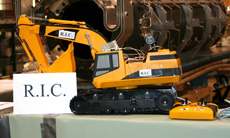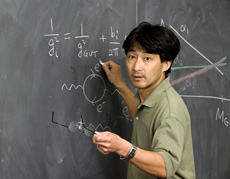|
Monday, Jan. 14
THERE WILL BE NO PARTICLE ASTROPHYSICS SEMINAR THIS WEEK
3:30 p.m.
DIRECTOR'S COFFEE BREAK - 2nd Flr X-Over
4 p.m.
All Experimenters' Meeting - Curia II
Tuesday, Jan. 15
3:30 p.m.
DIRECTOR'S COFFEE BREAK - 2nd Flr X-Over
4 p.m.
Accelerator Physics and Technology Seminar - One West
Speaker: G. Stancari, INFN Ferrara
Title: Production, Transport and Laser Trapping of Radioactive Francium Beams for the Study of Fundamental Interactions
Click here for NALCAL,
a weekly calendar with links to additional information. |
|
Wednesday, Jan. 16
Lunch
- Catfish fillet Veracruz
- Green rice
- Corn and red pepper
Thursday, Jan. 17
Dinner
- Closed
Chez Leon Menu
Call x4598 to make your reservation. |
|
|
NuMI's homemade helper

This toy construction vehicle, dubbed R.I.C. for Remote Illumination Caterpillar, was converted into an inexpensive inspection tool. The contraption allowed NuMI technicians to examine an area of the radioactive NuMI decay pipe.
A love of remote controlled cars and a stint fixing periscopes on U.S. Army tanks led to a groundbreaking inspection tool for particle accelerator beam lines.
"For long baseline neutrino experiments we're one of the first, so we had no model to follow for inspection of the decay pipe window for NuMI, or any ready-made tools for the job," said Kris Anderson, supervisor for NuMI target hall operations.
NuMI collaborators built an inspection periscope for a few hundred dollars by cobbling together spare steel, a digital camera and spotting scope, specially designed mirrors similar to those on NASA satellites and a toy construction vehicle.
The 15 foot long, 18-inch-wide contraption enabled NuMI technicians to reach deep into the beam shielding and peer into a perpendicular tunnel. They used the periscope and camera to look for wear and tear on the Numi decay pipe window. They needed to catch corrosion early to prevent countless lost hours and data, and at worst, a long shutdown to make repairs.
Keith Anderson, senior technician, knew from his U.S. Army days that he could devise a way to look into the tunnel. Technicians just had to find a way to bring illumination to the NuMI decay pipe window at the end of a 100-foot, dark tunnel. Engineer Ryan Schultz and Anderson drew inspiration from their children's remote- controlled cars to craft an inexpensive tool for a multimillion dollar neutrino experiment.
"It is mostly modeled after the children's milk-bottle periscope: a box with two mirrors on it," Keith Anderson said. A digital camera rested on the top of the periscope, away from the distorting radiation near the horn.
Anderson and his colleagues used a spotting scope rigged with a remote camera and a toy excavator equipped with lights and a 100-foot extension cable, because the concrete shielding blocked wireless controls.
The device may look simple, but it took four months of work at home and on lunch breaks to design, test and build.
--Tona Kunz
|
Hitoshi Murayama named
IPMU founding director
From The University of Tokyo, WPI Institute for the Physics and Mathematic of the Universe , Jan. 11, 2008

Hitoshi Murayama
Hitoshi Murayama was appointed this month as the founding director of Institute for the Physics and Mathematics of the Universe (IPMU) at the University of Tokyo. IPMU is a new international research institute in which English is to be its official language. The goal of the institute is to discover the fundamental laws of nature and to understand the universe from the synergistic perspectives of mathematics, statistics, theoretical and experimental physics, and astronomy.
IPMU was launched as one of the World Premier International Research Centner Initiative (WPI) of the Ministry of Education, Culture, Sports, Science and Technology (MEXT). Its projected annual budget is about $10M and is currently approved for ten years of operation. It is expected to have about 70 full-time scientists and involve more than a hundred collaborators.
Read more
|
Fed's cut $270 million from NE Minnesota research project
From Minnesota Public Radio's All Things Considered, Jan. 10, 2008
The people planning a $270 million physics experiment in northeast Minnesota got an unhappy surprise just before Christmas. The NoVa project will study high-energy particles in a huge building to be constructed not far from Voyageurs National Park. Everything was ready for a big new investment in the region -- until the project was cut from a federal spending bill that passed Congress a couple of weeks ago.
Duluth, Minn. - The NoVa project is an extension of a physics experiment underway in a below-the-surface laboratory in the Soudan State Park Underground Mine.
There, a series of huge plastic discs trap tiny energy particles. The particles are shot in a beam from the Fermi National Accelerator Laboratory hundreds of miles away near Chicago.
The NoVa project is to sample that same beam, but with a massive mineral oil detector, in a building almost as wide as a football field and 70 feet high.
Read more
Read a fact sheet on the impact of budget cuts on Office of Science programs.
See all related news stories here
|
|
|
Seasonal viruses
 |
| Sneezing into disposable tissues or on your upper arm can help prevent the spread of colds. Clip art licensed from the Clip Art Gallery on DiscoverySchool.com |
According to Medical Department Nurse Karen Swanson, the Medical Office has seen an unusual number of people sick with sinusitis and pneumonia. These illnesses are often brought on by viral respiratory infections. They also see people ill with gastro-intestinal viruses accompanied by high fevers.
Site Occupational Medical Director Dr. Brian Svazas said that viruses are primarily transmitted via contaminated surfaces and direct person-to-person contact. A major factor is the close proximity of people to each other. The same phenomenon is seen on ship cruises, at scout camps, and in military recruit bases, no matter what the weather. Here are some suggestions for minimizing your risk of seasonal infections.
Exposure avoidance - Sick people should avoid well people, and vice versa. Cough or sneeze into disposable tissues or on your upper arm. Wash hands frequently or use hand sanitizer (stock system sanitizing gel @ 1620-08520). Disinfect commonly-contacted surfaces between uses. Security Department Chief Bill Flaherty noted that the control console in the Communication Center is cleaned with an ammonia-based window cleaner between each shift.
Self care - Rest. If your temperature is 100-101oF or more, use a fever reducer. Acetaminophen is usually the first choice fever reducer because it's easy on the stomach. If you are vomiting, perspiring or have diarrhea, it is necessary to replace water lost with fluids. Hydration is also useful in respiratory infections to help thin mucous. Start re-hydration with water and move to sugar-containing drinks, especially if solid food is not tolerated. When able, try small amounts of bland solid foods, and then gradually return to your regular diet.
Outside help - Seek professional help if you have trouble breathing, a severe headache or stiff neck, severe weakness or dizziness, an extremely high fever or a fever that lasts more than three days.
Safety Tip of the Week Archive
|
New dark matter map shows violent life of galaxies
From National Geographic News,
Jan. 11, 2008
In galaxy clusters, the rough-and-tumble outer suburbs are where most galactic change occurs, a team of astronomers announced today.
There, galaxies harass, strangle, and strip away at each other as they are pulled from the outskirts of a cluster to the inner core by the gravity of dark matter, according to the new research.
The finding stems from detailed analysis of a massive supercluster of more than a thousand galaxies that lies about 2.6 billion light-years away from Earth.
Catherine Heymans, an astrophysicist at the University of British Columbia in Vancouver, Canada, used a mosaic of 80 Hubble images spanning 16 light-years to create a map of dark matter in the supercluster.
"This is the highest resolution of dark matter of one of the largest areas ever imaged by the Hubble Space Telescope," she said during a press briefing today at the 211th meeting of the American Astronomical Society (AAS) in Austin, Texas.
Dark matter does not emit light, making it invisible. But based on long-standing theories of gravity, scientists think dark matter makes up the vast majority of mass in the universe.
Read more
|
|
Have a safe day!
Project X physics workshop Jan. 25-26
Fermilab will host a second users' workshop Jan. 25-26 to discuss the physics of Project X. The workshop will focus on the details of the experiments that might be proposed to take advantage of a high-intensity proton source, their physics impact
and the development of the overall experimental strategy. Information about the
workshop, working groups and ongoing efforts is available online.
New location for International Services
The Visa Office and Assignment Services have joined the User's Office to form International Services. The office has moved to the first floor of Wilson Hall on the west side. The contact information is as follows: Amanda Petersen, x4203; Barb Book, x3111; Melissa Clayton Lang, x3933; and John Galvan, x3811. The mail stop is MS 103 and the fax is x3688.
Pidgin: Secured Onsite Instant Messaging Client course
A course on Pidgin, an instant messaging client supported by the Computing Division, will be offered Feb. 12 and 14. Learn what instant messaging has to offer and how to use Pidgin. Learn more and enroll
Scottish country dance Tuesday
Scottish country dancing will meet Tuesday, Jan. 15, at Kuhn Barn. Instruction begins at 7:30 p.m. and newcomers are always welcome. Most dances are fully taught and walked through, and you do not need to come with a partner. Call (630) 840-8194 or (630) 584-0825 or e-mail for more information.
Additional Activities
|
|